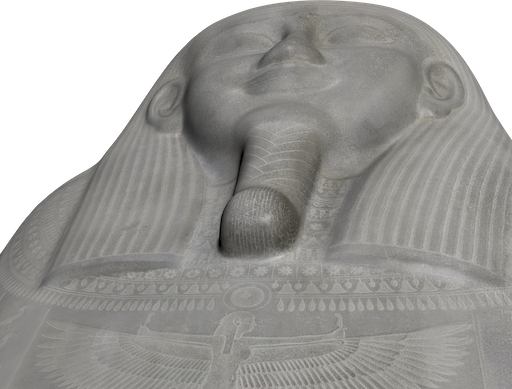psmTk
The sarcophagus lid was probably purchased in Feb. 1900 by W. R. Hearst himself, on a trip to Egypt. Though the museum has no records of the purchase, archaeologist George Reisner, who was then working for Hearst's mother, mentions that he met Hearst and that they purchased antiquities together during Hearst's trip to Egypt. The sarcophagus arrived in Berkeley by ship in 1903 and was presented to the museum as a gift from Hearst. Professor Klaus Baer later connected the lid with that found by Barsanti & Maspero in 1900 and published in 19011, allowing us to speculate that Hearst probably bought the coffin from the Antiquities Service in Egypt. A stela belonging to a man named Psamtik with the same titles and mother was found in the Serapeum2. This stela can be dated to the 26th year of the reign of Amasis in the 26th Dynasty. It also gives us the name of Psamtik's father, who is never mentioned in his tomb3. The sarcophagus then, would probably date towards the end of the 26th dynasty. This corresponds with stylistic dating based on parallels of both the sarcophagus and tomb 4.
As for the Doctor himself, he was an overseer of an enclave of Libyan mercenaries as well as the Chief of Physicians5. He had the wealth and proximity to the king to build himself a magnificent tomb in the form of a room-sized underground sarcophagus. Of his family, we know very little beyond their names. His mother was named Tagemiraset, and his father was Harsiese. He may also have been related to a lady named Setjairetbinet, whose intact burial was found in a side-room of his tomb6.
Strangely, the Doctor was never buried in his tomb, and the basalt sarcophagus lid was left propped above its basin, waiting for his body to be deposited inside. Maspero thinks he might have died in the struggles with the Persians that ended the Dynasty7 but Elsasser colorfully proposes that he was executed for malpractice!8 The fate of the doctor will probably remain a mystery.
- 1 Elsasser, A. B. (1966). The Mummy that Never Arrived. The California Monthly (May): 52-54. pg 52-54
- 2 In the original publication of the tomb, Maspero quotes a correspondance with Chassinat, who realized that Mariette had excavated a stele bearing the same name, titles, and mother as inscribed in Psamtik's tomb. This stele not only allows for the dating of the tomb, but also provides us with the name of Psamtik's father.
Barsanti, M. A., & Maspero, M. G. (1900). Fouilles autour de la pyramide d’Ounas: II. Les tombeaux de Psammétique et de Sétariban. Annales Du Service Des Antiquités de l’Égypte, 1, p185. - 3 The stele is Louvre IM 4084.
- 4 el-Sadeek, W. (1984). 26th Dynasty Necropolis of Giza. Vienna, Institute Für Afrikanistik und Ägyptologie der Universitat Wien. pg 207
- 5After Barsanti & Maspero, Les tombeaux de Psammétique et de Sétariban, 186-187.
- 6 Bareš has noted that subsidiary burials in 26th dynasty tombs of the "Persian Pit" type are quite rare, and when they occur, the occupants can have a variety of relationships to the tomb owner. Setjairetbinet's mother is not the same as the Doctor's, so they aren't full siblings.
Bareš, L. (2007). Lesser Burial Chambers in the Large Late Period Shaft Tombs and their Owners. In Z. Hawass & J. Richards (Eds.), The Archaeology and Art of Ancient Egypt: Essays in Honor of David B O'Connor (Vol. 1). Cairo: Conseil Suprême des Antiquités de l'Égypte. - 7After Barsanti & Maspero, Les tombeaux de Psammétique et de Sétariban, 189.
- 8 Elsasser Mummy that Never Arrived, 53.
- Barsanti, M. A., & Maspero, M. G. (1900). Fouilles autour de la pyramide d’Ounas: II. Les tombeaux de Psammétique et de Sétariban. Annales Du Service Des Antiquités de l’Égypte, 1, 150-189
- Elsasser, A. B. (1966). "The Mummy that Never Arrived." The California Monthly(May): 52-54. pg 52-54
- Gestermann, L. (2001). "Grab und Stele von Psametich, Oberarzt und Vorsteher der TmH.w." Revue d'Égyptologie(52): 127-149.
- Porter, B., & Moss, R. L. B. (1981). Topographical Bibliography of Ancient Egyptian Hieroglyphic Texts, Reliefs, and Paintings. (J. Malek, Ed.) (Vol. IIIb). Oxford: Griffith Institute. pg 811
- el-Sadeek, W. (1984). 26th Dynasty Necropolis of Giza. Vienna, Institute für Afrikanistik und Ägyptologie der Universität Wien.
- Stoss, F. H., & Elsasser, A. B. (1973). “The Doctor”: a 26th Dynasty Sarcophagus Lid. Berkeley.
